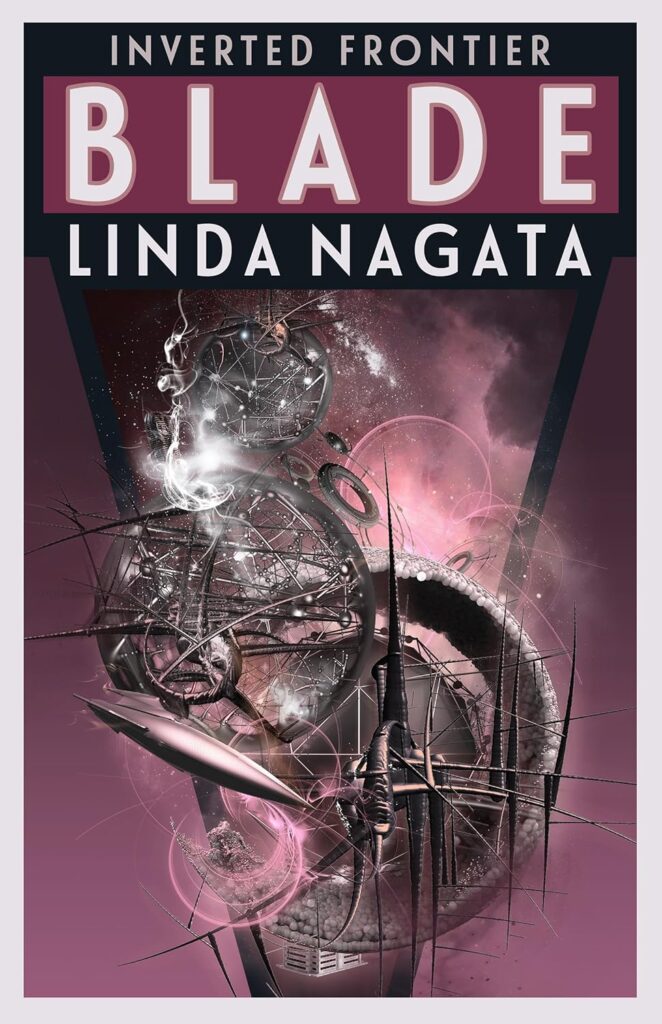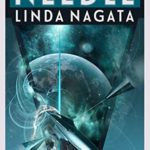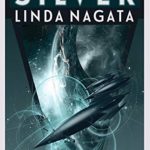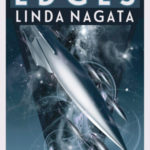In previous novels of the Inverted Frontier series (Edges, Silver and Needle), Linda Nagata often posed the question of what it took to retain humanity in the face of alien power. In Blade Inverted Frontier 4 (out of a projected 5 volume series) she confronts as never before the potential of human destructiveness. Is it possible for humans to use nearly god-like energies for benign purposes, and can they even control the power they have come to possess?
The theme is sounded at the outset of Blade Inverted Frontier 4. The converted living warship Dragon, once an alien engine of destruction but long under the control of the human leader Urban, is guiding a small fleet of ships with several dozen humans on a millennia-long voyage. They are traveling from the last known outpost of human settlement back to the scene of destruction of what had been Earth and its many outlying settled planets and systems. Scouting ahead is another converted warship, Griffin, a living entity like Dragon that was once under the control of a vanished race called the Chenzeme, dedicated to seeking out and destroying other forms of intelligent life.
Griffin is guided by sentient philosopher cells that, in their original Chenzeme form, constantly scanned space for enemies to be destroyed. Converting these cells to peaceful purposes has taken an enormous effort by the ghost, or uploaded version of the key crew member, Clemantine. However, after centuries of operating on its own, this ghost of Clemantine seems to be turning to the dark side, listening more and more to the hostility of Griffin’s cells. Rather than controlling and pushing them in a peaceful direction, she now has fallen into their depths of instinctive desire to kill any potential target of intelligent life. As the Dragon perceives a distant ship, potentially created by humans, the crew wants to visit and explore, but Griffin does not respond to commands and seems to be getting ready to destroy this new “target.”
This distant ship turns out to be one of the type that used to carry humans across the star systems. Now its only occupants are Tio Suthrom, an uploaded human mind of a man whose physical form has long since perished. With him is Ashok, a synthetic or machine, known as one of the Inventions, created by aliens within the Hupo Sei system. Urban cautiously communicates with this ship to test its friendliness or hostility, and Tio responds with equal caution. He has become embittered about the human capacity for destruction and wants nothing more to do with his species.
But Griffin poses a looming threat as it begins to perceive this newly detected ship as an enemy, leading its sentient cells to build a consensus around the Chenzeme refrain, “Kill it!” The only recourse for Urban and others on board the Dragon, including Clemantine in her original human form, is to mount an attack on the Clemantine ghost that has been corrupted and retake control of the sentient cells in Griffin.
So from the outset, the theme of potential human destructiveness comes to the fore. It intensifies as the crew of Dragon overcome the initial skepticism of Tio and Ashok on the great ship and arrange to have crew members visit each other’s vessels to establish good faith. Urban and the Cryptologist, a human-like virtual entity with special powers, seek permission from the rest of the crew and from the Inventions of Hupo Sei to visit that system.
There they find a vast mangled array of destroyed structures, a world in fragments, populated only by strange monstrous creatures called IRKs which were construction robots whose programming was corrupted. Instead of rebuilding the fractured structures, they began to consume the shattered elements to create more of their kind. The rulers among the Inventions see an opportunity in their human visitors. Perhaps they can help destroy the IRKs and rebuild a functional world.
They might be able to do this by using the powers that Urban and the Cryptologist have gained over the strange element known as silver, which could enable them to build an entity called the Blade. This is a barely controllable power that could either be a creative force of vast energy to generate a new world or a destructive one that could obliterate everything within its range.
This is one of those points in the story that depends on a knowledge of the earlier books. Inverted Frontier is really one long story, divided into a series of discrete adventures, but which build on one another. In Silver, second in the series, Urban and the crew of Dragon have their most fateful and powerful encounter with a godlike entity known as Lezuri. It is he, along with a goddess who has since vanished, who created the world of Verilotus, a ring world regularly inundated with the element called silver. This element was essential for Lezuri to realize his great powers. In a spectacular confrontation with Lezuri, Urban had been infused with enough silver that might enable him to create a Blade, with the Cryptologist’s help. Even though she had never encountered Lezuri, she had absorbed alll of Urban’s memories and with them the power to generate silver. But this is a power that could easily destroy them.
The stakes are high, and neither Urban nor the Cryptologist are sure that they will be able to generate enough silver to create a Blade or, even if they can, that they can then control this vast entity to shape a new world. The story builds to what is for me the most exciting climax of the four books in the Inverted Frontier series thus far. Nagata brilliantly captures the fine line they tread together to access a world-generating power:
“Entanglement deepened, minds blending ever further together, flowing together, expanding deeper into a once-hidden fabric of existence until a new sense blossomed. There, just there—almost here—barricaded behind the thinnest wall: another Cosmos. A reservoir of impossible energies just on the other side of a forbidden boundary.”
Blade – pre-copyedit ebook version. Location 3535
While the relationship between Urban and the Cryptologist becomes incredibly intimate as they work together to unleash vast energies, it is the relationship between Urban and Clemantine that is the core of the series. Even after they establish intimacy with others – Clemantine with the avatar of Tio Suthrem in this story and Urban with the avatar of the Cryptologist – and the misunderstandings and anger those provoke, they keep finding ways of assuring one another that their basic love is unbroken. It is one of the powerful human bonds that unifies the series, even though the relationship seems destined to remain as full of mistrust and strain as of affection and intimacy.
My only criticism of Blade is that it has too little background on previous events for a reader who isn’t completely immersed in the earlier books to fully understand the significance of certain dimensions of the story. It’s always a tricky balance between too little background and excessive repetition of key events from previous adventures (C.J. Cherryh is famous for elaborate info dumps of back story in her Alliance universe series). In the earlier books, I thought that Linda Nagata hit that balance just right, but in this one I kept having to go back and refresh my memory about certain characters, planet names and events. A glossary for the series might be helpful, especially for a reader who picks up Blade without having read the earlier books. Despite that, I can’t recommend Blade and the whole series highly enough. This story in particular builds to a feverishly paced climax that makes Blade a high point of the series. Nagata has created a unique and powerful form of space adventure.
My thanks to Mythic Island Press for an advance ebook copy of Blade for this review, based solely on my own opinions.





Leave a Reply